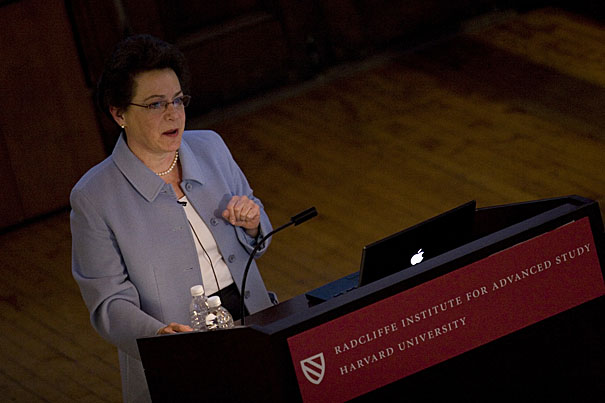
Radcliffe Dean Barbara J. Grosz says her goal is to advance research and to promote cooperation among faculty members by providing them with resources and space that foster collaboration.
File photo Nick Welles/Harvard Staff Photographer
Seeding new ventures at Radcliffe
Institute will engage faculty from multiple disciplines
To meet the faculty associates for the Radcliffe Institute, you would have to travel from one end of Harvard’s campus to the other, from the bustling streets of the Longwood Medical Area to bucolic Observatory Hill, with stops at the Barker Center across from Harvard Yard, the shiny new Center for Government and International Studies on Cambridge Street, and the towering William James Hall on Kirkland Street. Then you would have to call Berlin, where a faculty associate is at an institute for advanced study, the Wissenschaftskolleg zu Berlin.
This geographic span shows the breadth of Radcliffe’s Academic Engagement Programs (AEP), the faculty-led initiative that Barbara J. Grosz, dean of the Radcliffe Institute and Higgins Professor of Natural Sciences in Harvard’s School of Engineering and Applied Sciences, is building. “We want to engage faculty from all disciplinary areas to explore new approaches to pressing questions,” said Grosz, who served as Radcliffe’s dean of science from 2001 until 2008. Grosz says her goal is to advance research and to promote cooperation among faculty members by providing them with resources and space that foster collaboration.
Since becoming dean of the institute, Grosz has appointed six new faculty associates, all of them accomplished in their fields: Ewa Lajer-Burcharth, Brigitte Madrian, Leah Price, Robert J. Sampson, Dimitar D. Sasselov, and Rosalind A. Segal.
Ewa Lajer-Burcharth, a Radcliffe faculty associate in the humanities and the William Dorr Boardman Professor of Fine Arts in the Department of History of Art and Architecture, has worked with a faculty committee drawn from across the University to design the institute’s annual gender conference for April 15-16, 2010. At the conference, artists and scholars will explore the ways that gender affects how people experience physical and personal spaces and how space affects the way they think about gender.
Leah Price, RI ’07, a Radcliffe faculty associate in the humanities and a Harvard College professor in the English Department, and Ann Blair, a former Radcliffe faculty associate in the humanities, a Harvard College professor in the History Department, and the Henry Charles Lea Professor of History, will convene academics, librarians, and students at the institute next fall for a conference called “Why Books?” on Oct. 28-29. Realizing a vision of Grosz and Diana Sorensen, dean of the arts and humanities in the Faculty of Arts and Sciences, and planned in consultation with faculty from a range of fields, the conference will further conversations on the history and future of books.
One of the most ambitious AEP ventures is the City as Social Science Laboratory, part of the Radcliffe Institute’s new Policy Studies Initiative, designed by Robert J. Sampson and Brigitte Madrian, the institute’s social science faculty associates. Madrian and Sampson are working with faculty from other Schools at the University to link records in the Boston area — including medical reports, crime records, census data, and immigration information — with the goal of studying city problems such as substandard housing, failing schools, and crime.
“There’s a wealth of data in the Boston area that researchers and administrators in local institutions have compiled,” said Sampson, chairman of Harvard’s Department of Sociology and the Henry Ford II Professor of the Social Sciences. He and Madrian, the Aetna Professor of Public Policy and Corporate Management at the Harvard Kennedy School, think Boston has been underutilized as a laboratory for social issues. By launching the City as Social Science Laboratory, Madrian and Sampson can bring local practitioners together with leading academic researchers and apply data to urban problems.
Madrian and Sampson have strong ties to other social scientists at Harvard. Among their collaborators is Nancy E. Hill, a professor at Harvard’s Graduate School of Education, who was named the first appointee to Radcliffe Institute’s Suzanne Young Murray Professorship in July.
To work with AEP faculty to strengthen the institute’s connections across the University and to expand AEP activities, Grosz has appointed Rebecca Wassarman as director of AEP. A longtime member of the Harvard community, Wassarman has already collaborated with faculty members and senior administrators at many Harvard Schools. She earned an A.B. in history from Harvard and a J.D. from the University of Michigan Law School.
Discussing the AEP initiatives, Grosz described the institute as an “engine of intellectual innovation.” The institute has supported activities that engage Harvard faculty members, students, fellows, and the public. But organizing these activities under the one AEP umbrella is Grosz’s innovation. “The best way to draw people at the University together is to engage people from its different parts to address important problems,” Grosz said. “That’s how the Radcliffe Institute is seeding new intellectual ventures.”
“This is a terrific program,” said Harvard President Drew Faust. “It places the Radcliffe Institute at the center of our efforts to foster collaboration among faculty members from across the University who bring a range of disciplinary perspectives to issues of pressing concern.”
Pat Harrison is publications manager at the Radcliffe Institute for Advanced Study.



